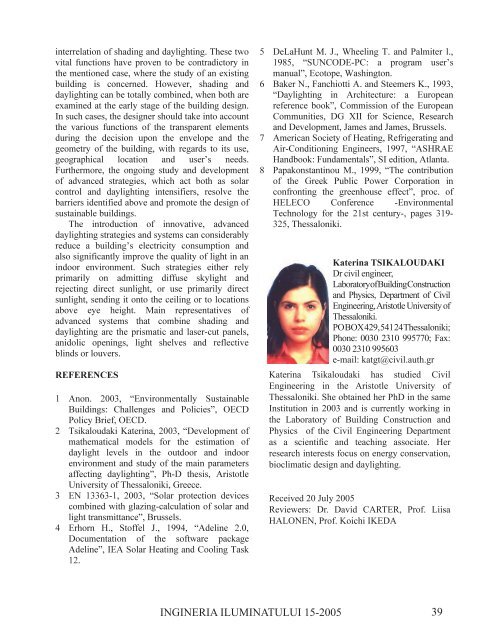Ingineria Iluminatului - Journal of Lighting Engineering - Prof. Florin ...
Ingineria Iluminatului - Journal of Lighting Engineering - Prof. Florin ...
Ingineria Iluminatului - Journal of Lighting Engineering - Prof. Florin ...
Create successful ePaper yourself
Turn your PDF publications into a flip-book with our unique Google optimized e-Paper software.
interrelation <strong>of</strong> shading and daylighting. These two<br />
vital functions have proven to be contradictory in<br />
the mentioned case, where the study <strong>of</strong> an existing<br />
building is concerned. However, shading and<br />
daylighting can be totally combined, when both are<br />
examined at the early stage <strong>of</strong> the building design.<br />
In such cases, the designer should take into account<br />
the various functions <strong>of</strong> the transparent elements<br />
during the decision upon the envelope and the<br />
geometry <strong>of</strong> the building, with regards to its use,<br />
geographical location and user’s needs.<br />
Furthermore, the ongoing study and development<br />
<strong>of</strong> advanced strategies, which act both as solar<br />
control and daylighting intensifiers, resolve the<br />
barriers identified above and promote the design <strong>of</strong><br />
sustainable buildings.<br />
The introduction <strong>of</strong> innovative, advanced<br />
daylighting strategies and systems can considerably<br />
reduce a building’s electricity consumption and<br />
also significantly improve the quality <strong>of</strong> light in an<br />
indoor environment. Such strategies either rely<br />
primarily on admitting diffuse skylight and<br />
rejecting direct sunlight, or use primarily direct<br />
sunlight, sending it onto the ceiling or to locations<br />
above eye height. Main representatives <strong>of</strong><br />
advanced systems that combine shading and<br />
daylighting are the prismatic and laser-cut panels,<br />
anidolic openings, light shelves and reflective<br />
blinds or louvers.<br />
REFERENCES<br />
1 Anon. 2003, “Environmentally Sustainable<br />
Buildings: Challenges and Policies”, OECD<br />
Policy Brief, OECD.<br />
2 Tsikaloudaki Katerina, 2003, “Development <strong>of</strong><br />
mathematical models for the estimation <strong>of</strong><br />
daylight levels in the outdoor and indoor<br />
environment and study <strong>of</strong> the main parameters<br />
affecting daylighting”, Ph-D thesis, Aristotle<br />
University <strong>of</strong> Thessaloniki, Greece.<br />
3 EN 13363-1, 2003, “Solar protection devices<br />
combined with glazing-calculation <strong>of</strong> solar and<br />
light transmittance”, Brussels.<br />
4 Erhorn H., St<strong>of</strong>fel J., 1994, “Adeline 2.0,<br />
Documentation <strong>of</strong> the s<strong>of</strong>tware package<br />
Adeline”, IEA Solar Heating and Cooling Task<br />
12.<br />
5 DeLaHunt M. J., Wheeling T. and Palmiter l.,<br />
1985, “SUNCODE-PC: a program user’s<br />
manual”, Ecotope, Washington.<br />
6 Baker N., Fanchiotti A. and Steemers K., 1993,<br />
“Daylighting in Architecture: a European<br />
reference book”, Commission <strong>of</strong> the European<br />
Communities, DG XII for Science, Research<br />
and Development, James and James, Brussels.<br />
7 American Society <strong>of</strong> Heating, Refrigerating and<br />
Air-Conditioning Engineers, 1997, “ASHRAE<br />
Handbook: Fundamentals”, SI edition, Atlanta.<br />
8 Papakonstantinou M., 1999, “The contribution<br />
<strong>of</strong> the Greek Public Power Corporation in<br />
confronting the greenhouse effect”, proc. <strong>of</strong><br />
HELECO Conference -Environmental<br />
Technology for the 21st century-, pages 319-<br />
325, Thessaloniki.<br />
Katerina TSIKALOUDAKI<br />
Dr civil engineer,<br />
Laboratory <strong>of</strong> Building Construction<br />
and Physics, Department <strong>of</strong> Civil<br />
<strong>Engineering</strong>, Aristotle University <strong>of</strong><br />
Thessaloniki.<br />
PO BOX 429, 541 24 Thessaloniki;<br />
Phone: 0030 2310 995770; Fax:<br />
0030 2310 995603<br />
e-mail: katgt@civil.auth.gr<br />
Katerina Tsikaloudaki has studied Civil<br />
<strong>Engineering</strong> in the Aristotle University <strong>of</strong><br />
Thessaloniki. She obtained her PhD in the same<br />
Institution in 2003 and is currently working in<br />
the Laboratory <strong>of</strong> Building Construction and<br />
Physics <strong>of</strong> the Civil <strong>Engineering</strong> Department<br />
as a scientifi c and teaching associate. Her<br />
research interests focus on energy conservation,<br />
bioclimatic design and daylighting.<br />
Received 20 July 2005<br />
Reviewers: Dr. David CARTER, Pr<strong>of</strong>. Liisa<br />
HALONEN, Pr<strong>of</strong>. Koichi IKEDA<br />
INGINERIA ILUMINATULUI 15-2005 39<br />
7
















